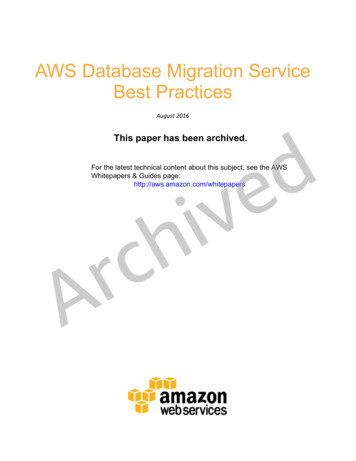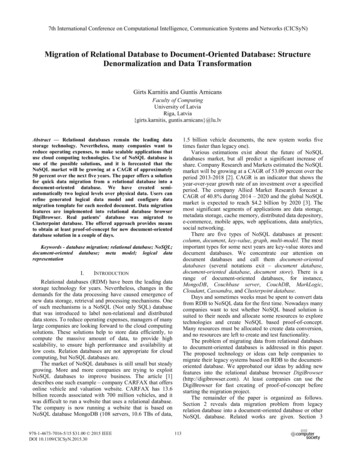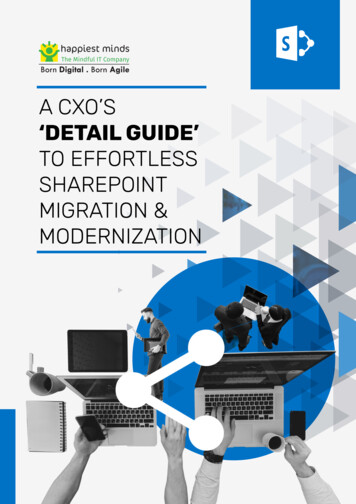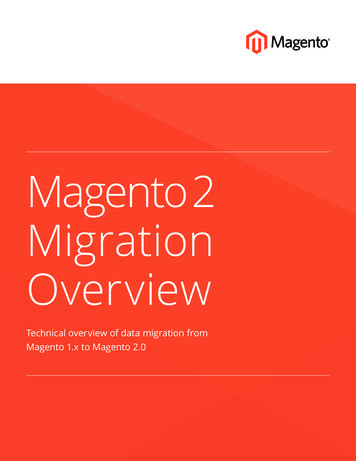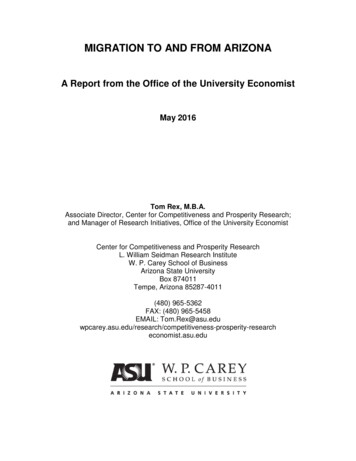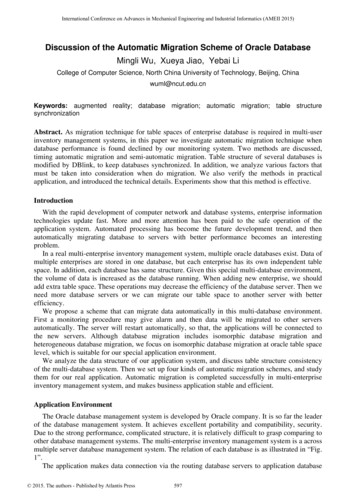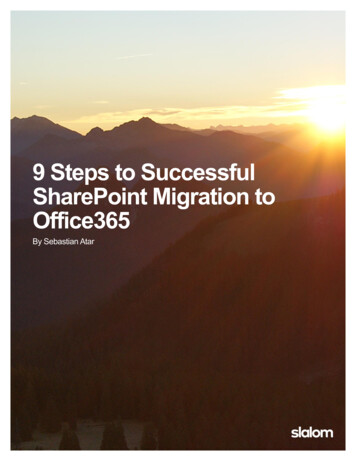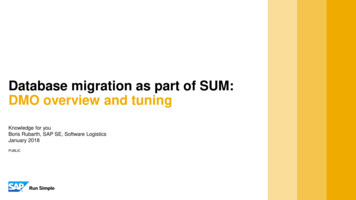
Transcription
Database migration as part of SUM:DMO overview and tuningKnowledge for youBoris Rubarth, SAP SE, Software LogisticsJanuary 2018PUBLIC
Legal disclaimerThe information in this presentation is confidential and proprietary to SAP and may not be disclosed without thepermission of SAP. This presentation is not subject to your license agreement or any other service or subscriptionagreement with SAP. SAP has no obligation to pursue any course of business outlined in this document or any relatedpresentation, or to develop or release any functionality mentioned therein. This document, or any related presentationand SAP's strategy and possible future developments, products and or platforms directions and functionality are allsubject to change and may be changed by SAP at any time for any reason without notice. The information in thisdocument is not a commitment, promise or legal obligation to deliver any material, code or functionality. Thisdocument is provided without a warranty of any kind, either express or implied, including but not limited to, the impliedwarranties of merchantability, fitness for a particular purpose, or non-infringement. This document is for informationalpurposes and may not be incorporated into a contract. SAP assumes no responsibility for errors or omissions in thisdocument, except if such damages were caused by SAP s willful misconduct or gross negligence.All forward-looking statements are subject to various risks and uncertainties that could cause actual results to differmaterially from expectations. Readers are cautioned not to place undue reliance on these forward-looking statements,which speak only as of their dates, and they should not be relied upon in making purchasing decisions. 2018 SAP SE or an SAP affiliate company. All rights reserved. ǀ PUBLIC2
Knowledge Transfer Sessions on Software Update Manager (SUM) (delivered)"Software Update Manager: Overview and Scenarios" (delivered)"SUM: downtime optimizations like nZDM, ZDO in detail" Today"Database migration as part of SUM: DMO overview and tuning" Wed 14.02.2018 1-2 pm "SUM: the tool for System Conversion to SAP S/4HANA" 2018 SAP SE or an SAP affiliate company. All rights reserved. ǀ PUBLIC3
DisclaimerThis presentation outlines our general product direction and should not be relied on in making apurchase decision. This presentation is not subject to your license agreement or any otheragreement with SAP. SAP has no obligation to pursue any course of business outlined in thispresentation or to develop or release any functionality mentioned in this presentation. Thispresentation and SAP's strategy and possible future developments are subject to change and maybe changed by SAP at any time for any reason without notice. This document is provided without awarranty of any kind, either express or implied, including but not limited to, the implied warranties ofmerchantability, fitness for a particular purpose, or non-infringement. SAP assumes noresponsibility for errors or omissions in this document, except if such damages were caused bySAP intentionally or grossly negligent. 2018 SAP SE or an SAP affiliate company. All rights reserved. ǀ PUBLIC4
Agenda Database Migration Option (DMO) with SUMWhat is DMO? What use cases? Which kind of systems?How does it work? Procedure detailsHow to tune and optimize downtime? Aspects for technical downtime of DMO procedure 2018 SAP SE or an SAP affiliate company. All rights reserved. ǀ PUBLIC5
DMO in a nutshellDatabase Migration Option (DMO): SUM use case for AS ABAP based systems, using SUM 1.0 (target 7.50) or SUM 2.0 (target 7.50) Database Migration: migrate a system to a different database type (heterogenous migration) In-place procedure: database (host) is switched, but Primary Application Server (PAS) host is kept Initially only target database type SAP HANA, now additional targets possible (see SAP note on DMO) System Conversion from SAP ERP to SAP S/4HANA uses DMO (if source database not yet SAP HANA)DMO is alternative approach to classical migration (heterogenous system copy) System update, Unicode Conversion* and database migration combined in one tool, one downtime Migration steps are simplified: consultant certification not required Business Downtime is reduced SAP’s recommendation for migration target SAP HANA database: use DMO, if possible(see ration-procedures-to-sap-hana-database/ ) 2018 SAP SE or an SAP affiliate company. All rights reserved. ǀ PUBLIC* Only for target systems below BASIS 7.506
Comparison of migration options – example: SAP HANA databaseSAP ECC 6.0EHP7AS ABAP 7.4Kernel 7.4xUnicodeMigrationSourceDBUpdateClassicalUnicode conversion upgrade DB migrationSAP ECC 6.0EHPxAS ABAP 7.0xKernel 7.x 2018 SAP SE or an SAP affiliate company. All rights reserved. ǀ PUBLICSourceDBSAP ECC 6.0EHP7AS ABAP 7.4Kernel 7.4xDMO of SUM7
DMO: Business CaseUpgrade and migration in a combined procedure reduces TCO and risksCombined procedure needs only one maintenance phase (not two) Reduces business downtime (TCO), less regression tests necessaryIn-place migration keeps application server and System-ID stable Low impact on system landscape: only database server is newOriginal database is kept, can be reactivated as fallback Reduces risk, no restore required, more time for testing before cutoverNo necessity for big export file share during migration Direct migration transfer without large dump files 2018 SAP SE or an SAP affiliate company. All rights reserved. ǀ PUBLIC8
DMO phases during the procedureSourceDB2Uptime(until downtime phase)EnterNoteSource database continues to run,but is no longer used to store data- easy reset possible 2018 SAP SE or an SAP affiliate company. All rights reserved. ǀ PUBLICSetup SAP HANAspecifics (client, schema )Upgrade“Prepare”Execute Upgrade3Time1SAPSystemdowntimeDowntime4Migrate application data5Finalize Upgrade6Start SAP HANA-based system(incl. data conversion)9
DMO use cases (1/2) DMO is the combination of update and migration,potentially with Unicode Conversion (target 7.50)SUM runs on PAS host (“inplace”),SUM starts R3load on that hostRunning SUM on AAS (Additional AS) is possible(restrictions apply, see SAP note on DMO),Benefit: run SUM on host with best resourcesAASPASSUMUpdate*AnyDBMigrateAnyDB ‘„DMO without Software Update“:use case to migrate only, no update of SAP software 2018 SAP SE or an SAP affiliate company. All rights reserved. ǀ PUBLIC10
DMO use cases (2/2) DMO not supported for data center migration due to latency issues(source & target database in separate data center) DMO with System Move“DMO with System Move”:use case to move complete SAP system Allows to switch PAS hostSUM Allows to migrate across data centers Requirement: set up of target database and PAS Sequence:MigrateAnyDBAnyDB ‘Update* Start SUM in source, export happens Copy and start SUM on target, import happens Can be combined with “DMO without Software Update” and with “SUM on AAS” 2018 SAP SE or an SAP affiliate company. All rights reserved. ǀ PUBLIC11
Agenda Database Migration Option (DMO) with SUMWhat is DMO? What use cases? Which kind of systems?How does it work? Procedure detailsHow to tune and optimize downtime? Aspects for technical downtime of DMO procedure 2018 SAP SE or an SAP affiliate company. All rights reserved. ǀ PUBLIC12
DMO: SUM StartPAS HostPRD InstancePASSourceKernelSAP Host AgentSUM is startedSUMPRD REPApplication DataSource DB Host 2018 SAP SE or an SAP affiliate company. All rights reserved. ǀ PUBLICTarget DB Host13
DMO: Shadow system createdPAS HostPRD InstancePASSourceKernelSAP Host AgentSUMUptime:Shadow systemis createdSHD InstanceSHDKernelPRD REPLegendeSHD REPTargetReleaseApplication DataSource DB Host 2018 SAP SE or an SAP affiliate company. All rights reserved. ǀ PUBLICTarget DB HostSourceRelease14
DMO: shadow repository migratedPAS HostPRD InstanceSAP Host AgentPASSUMSourceKernelSHD KernelR3loadPRD REPUptime:Shadow repositoryis migratedTGT KernelR3loadTGT REPSHD REPApplication DataSource DB Host 2018 SAP SE or an SAP affiliate company. All rights reserved. ǀ PUBLICTarget DB Host15
DMO: application tables are migratedPAS HostPRD InstanceSAP Host AgentPASSUMSourceKernelSHD KernelR3loadPRD REPDowntime:Application tablesare migratedTGT KernelR3loadTGT REPSHD REPApplication DataSource DB Host 2018 SAP SE or an SAP affiliate company. All rights reserved. ǀ PUBLICApplication DataTarget DB Host16
DMO: update partPAS HostPRD InstancePASTGTKernelPRD REPSAP Host AgentDowntime:Target kernel is usedSUMTGT REPSHD REPApplication DataSource DB Host 2018 SAP SE or an SAP affiliate company. All rights reserved. ǀ PUBLICApplication DataTarget DB Host17
DMO: procedure finishedPAS HostPRD InstanceSAP Host AgentPASSUMTGTKernelPRD REPDowntime:Application tablesare updatedProcedure finishedTGT REPSHD REPApplication DataSource DB Host 2018 SAP SE or an SAP affiliate company. All rights reserved. ǀ PUBLICApplication DataTarget DB Host18
Agenda Database Migration Option (DMO) with SUMWhat is DMO? What use cases? Which kind of systems?How does it work? Procedure detailsHow to tune and optimize downtime? Aspects for technical downtime of DMO procedure 2018 SAP SE or an SAP affiliate company. All rights reserved. ǀ PUBLIC19
Tune and optimize downtime Downtime is dominated by migration part Migration is influenced by Number of R3loads configured for downtime Network bandwidth: 10 Gbit/s network card, no firewall Rule of thumb: migration rate of 300 GB/hours should be possible in standard set upwith an estimated additional 8 hours for the update part, technical downtime can be estimated Task is to optimize number of R3load processes Table split calculated by SUM automatically, based on table size Keep source database statistic up to date Optimize table split calculation by providing table duration files from previous run 2018 SAP SE or an SAP affiliate company. All rights reserved. ǀ PUBLIC20
Downtime optimization: overview Use Benchmarking before the DMO run: quick testBenchmarking focuses on migration (no shadow system) Adjust number of R3load processesduring Benchmarking, and during DMO procedure Use the Test Cycle Optionthis allows a fast repetition of only the downtime migration for a test run, no need to start from scratch Provide the migration duration file from previous run:it lists measured table migration duration, SUM will use this for optimized table split Consider downtime optimized techniques: Downtime-optimized DMO: moves migration partly to uptime(for SAP Business Suite systems, currently in pilot phase, SAP Note 2442926) Delta queue cloning (for SAP BW systems) NZDT Service approach (SAP Note 693168) 2018 SAP SE or an SAP affiliate company. All rights reserved. ǀ PUBLIC21
Recommended Procedure Start with the Benchmarking tool Export only mode with 100 % of all tables: log file shows total database size to be migratedExport only mode with 10 % of all tables: shows potential bottleneck in source databaseExport & Import mode with 10 % of all tables: first impression on migration rateVary number of R3loads to find optimum, use migration repetition option (test cycle) for fast repeat Continue with DMO, reuse duration file from benchmarking run, use migration repetition option See following information source on this:SCN blog: formance 2018 SAP SE or an SAP affiliate company. All rights reserved. ǀ PUBLIC22
Further Information for DMO of SUMCentral Release NoteSoftware Logistics Toolset 1.0 – 63579DMO with SUM 1.0 SP 5DMO with SUM 2.0 SP 7SAP Support Portalquick link: /sltoolsethttp://support.sap.com/sltoolsetSAP Community blog on DMOhttps://blogs.sap.com/?p 349580 2018 SAP SE or an SAP affiliate company. All rights reserved. ǀ PUBLIC23
2018 SAP SE or an SAP affiliate company. All rights reserved.No part of this publication may be reproduced or transmitted in any form or for any purpose without the express permission of SAP SE or an SAP affiliate company.The information contained herein may be changed without prior notice. Some software products marketed by SAP SE and its distributors contain proprietary software componentsof other software vendors. National product specifications may vary.These materials are provided by SAP SE or an SAP affiliate company for informational purposes only, without representation or warranty of any kind, and SAP or its affiliatedcompanies shall not be liable for errors or omissions with respect to the materials. The only warranties for SAP or SAP affiliate company products and services are those that areset forth in the express warranty statements accompanying such products and services, if any. Nothing herein should be construed as constituting an additional warranty.In particular, SAP SE or its affiliated companies have no obligation to pursue any course of business outlined in this docume nt or any related presentation, or to develop or releaseany functionality mentioned therein. This document, or any related presentation, and SAP SE’s or its affiliated companies’ strategy and possible future developments, products, andplatforms, directions, and functionality are all subject to change and may be changed by SAP SE or its affiliated companies a t any time for any reason without notice. The informationin this document is not a commitment, promise, or legal obligation to deliver any material, code, or functionality. All forward-looking statements are subject to various risks anduncertainties that could cause actual results to differ materially from expectations. Readers are cautioned not to place undu e reliance on these forward-looking statements, and theyshould not be relied upon in making purchasing decisions.SAP and other SAP products and services mentioned herein as well as their respective logos are trademarks or registered trade marks of SAP SE (or an SAP affiliate company)in Germany and other countries. All other product and service names mentioned are the trademarks of their respective companie s.See /index.epx for additional trademark information and notices.
this allows a fast repetition of only the downtime migration for a test run, no need to start from scratch Provide the migration duration file from previous run: it lists measured table migration duration, SUM will use this for optimized table split Consider downtime optimized techniques: Downtime-optimized DMO: moves migration partly to uptime
